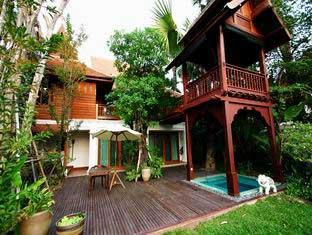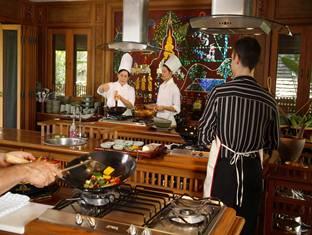
Set in over 60 acres of landscaped gardens, we offer a self contained world of beauty, incorporating serene paddy fields and exotic plantations. Mandarin Oriental Dhara Dhevi is Chiang Mai’s only luxury hotel and resort where you can enjoy one of the world’s most beautiful spas and surround yourself with the rich heritage of the Lanna Kingdom. It is 10 km to the centre of Chiang Mai
The design of our suites, villas and residences is a visual journey through the history of the Lanna region, from the glory of northern Thailand to the influences of neighbouring Myanmar, China and Laos and the introduction of colonial architecture. We offer our guests the choice of private two-floor villas, colonial-style suites or the grandeur of our Residences. All of our spacious suites and villas have separate sitting areas and generously proportioned bathrooms and some villas feature private outdoor plunge pools. Throughout our resort, we offer an atmosphere of culture and calm, with the display of beautiful artifacts from our private collection amidst the welcome shroud of lush tropical greenery.
 Deluxe Villa with Pool As the name suggests, the finest of all villas special for honeymoon couple with specific lucky room number comes with a very private pool and outdoor Jacuzzi together with the ultimate luxury of vast living space, which makes it hard to ever leave (even to go for breakfast). Other additional features are an outdoor deck, in-room massage area and upper terrace for sun bathing. This villa is approximately 244 square meters/2623 square feet.
Deluxe Villa with Pool As the name suggests, the finest of all villas special for honeymoon couple with specific lucky room number comes with a very private pool and outdoor Jacuzzi together with the ultimate luxury of vast living space, which makes it hard to ever leave (even to go for breakfast). Other additional features are an outdoor deck, in-room massage area and upper terrace for sun bathing. This villa is approximately 244 square meters/2623 square feet. Colonial Suite
Colonial Suite These luxurious suites feature a King or Twin bedroom, a living room which leads out onto a 22 square meter / 235 square feet terrace overlooking the gardens, and a bathroom with a whirlpool tub and separate shower stall. Connecting rooms, and rooms for those with special needs, are also available. The suites measure approximately 88 square meters/964 square feet.

Grand Deluxe Villa with Plunge Pool
This ultra luxurious two-storey teak wood Villa is facing the rice paddy fields. The ground floor’s additional features are a dining room, steam shower, massage area and your very own private plunge pool with a sun deck. The spacious bedroom upstairs comes with high ceiling and a King Bed. There is a separate study room and the usual bathroom luxurious features such as the whirlpool tub. This villa is approximately 200 square meters/2150 square feet.
Grand Deluxe Villa with Plunge Pool
This ultra luxurious two-storey teak wood Villa is facing the rice paddy fields. The ground floor’s additional features are a dining room, steam shower, massage area and your very own private plunge pool with a sun deck. The spacious bedroom upstairs comes with high ceiling and a King Bed. There is a separate study room and the usual bathroom luxurious features such as the whirlpool tub. This villa is approximately 200 square meters/2150 square feet.
Farang Ses Restaurant
Serving the finest French cuisine in Thailand, the restaurant is located in a magnificent Thai teak pavilion overlooking the resort’s paddy fields.
Fitness Centre

Colonial pool

Kids Rice Planting

Oriental Culinary Academy














